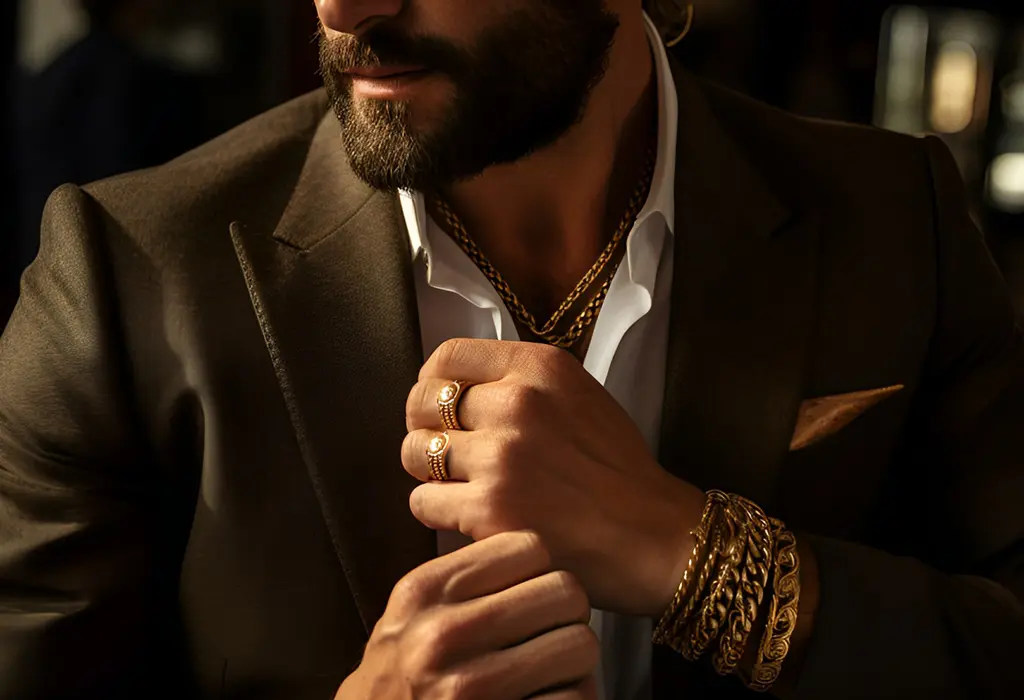“Real men don’t wear jewelry.”
Or how about…
“I don’t think I could pull that off.”
Have you ever heard those excuses?
I hear them all the time.
Gentleman, it is BS.
I understand many guys are not comfortable wearing jewelry.
And there is a right and wrong way to do it.
But there are several excuses that I see as cop outs.
It comes down to confidence!
Which is why I wrote this article.
Today's post will discuss 7 mistakes that men make when wearing jewelry…AND how to fix them.
1. Not Wearing Jewelry With Confidence

As a man of style, it's ok to push your boundaries a bit. Many guys don't wear jewelry because they're not confident in it. That's ok. All it takes is a bit of practice, but how?
Go visit the jeweler or a department store and try stuff on. It’s called window shopping. By doing this, you will get used to how you look in the pieces.
Many of the sales persons at jewelers are extremely knowledgeable about their products. It can, often times, be a very pleasant experience. It’s about building your confidence and that can only be done by getting out there and experimenting.
If you are in this bucket, you want to start with clean and crisp pieces. If you start trying on rings and bracelets that are really ornate, you might get overwhelmed and turned off. Keep it simple in the beginning and then (maybe) you can graduate to more elaborate items.
2. Not Paying Attention to Your Environment

For the guys who don’t mind sporting accessories, make sure that they are situationally appropriate. The environment is everything and when wearing jewelry it’s important that you pay attention to the rules or the general conventions. For example:
- Funerals – funeral outfits are not worn to get attention so any jewelry worn should be subtle so that you remain respectful
- At work/interview – always consult the dress code at your place of business and follow it. Keeping your jewelry modest is your safest bet as you don’t want to come across as unprofessional and braggadocios…especially in an interview
- School – For students who attend a learning institution with a specific dress code, jewelry may have a limit. Also, specific programs in college or graduate/professional school might have some set guidelines and expectations. Majors such as business, law, and political science might subscribe to strict professional dress codes.
3. Over-Accessorizing

You have to know how much jewelry is too much. There is an old saying that “jewelry is that last thing that you put on but the first thing that you see.”
Make sure that you tastefully accessorize with your outfits.
Nothing should overpower your clothes. Each accessory should compliment the entire look. While Mr. T was a stud, he doesn’t represent the dapper gentleman. Remember, less is more.
Another consideration is the type of outfit. You may be able to get away with certain types and amounts of jewelry with different looks. For example, earrings are not usually accepted when wearing a suit – but if you’re at the football game with the guys – go for it.
4. Wearing Jewelry Unbalanced

Jewelry that is unbalanced is the cousin to over-accessorizing as it can draw too much attention to one side/part of your body.
A great example is necklaces. Many guys will stack two or three necklaces on top of each other. This throws off the look because the eye is focused on the jewelry instead of the whole outfit. Not to mention stacking them crowds the neckline. This is not the proper way to wear necklaces.
Wrist wear is another great example. If you’re a guy who likes smaller watches, don’t wear bulky bracelets on the other wrist. It will make you look lopsided and uneven – again diverting attention from the look as a whole. The important thing is to make sure that all accessories maintain an equilibrium of sorts.
One way to throw off the balance is my mixing the metals. Try as best as possible to keep them the same. If you are wearing a two-toned bracelet watch, highlight the dominant metal with your other accessories.
5. Not Choosing Best Pieces of Jewelry for Your Skin Tone

Each one of us has undertones in our skin that will look great with certain metals and textiles. The way that you determine what metal looks best on you is to try on pieces. Use the following tips to determine your skin tone:
Look at you skin in natural light and find a spot wear veins are noticeable (your wrist is usually a good choice)
– Blue or purple veins = cool skin tone
– Green veins = warm skin tone
– Blue, green, AND purple veins = neutral skin tone
Once you have determined whether you have warm or cool undertones, it’s relatively easy to match the proper metal with your skin.
– Cool skin tones look best in light metals = white gold, platinum, or silver
– Warm skin tones work great with yellow metals = yellow gold, rose gold, brass
– Neutral skin tones = white and yellow metals
6. Assuming That All Jewelry Is Feminine

Let me be clear – jewelry is not feminine.
There are certain styles that may be considered less masculine than others but to say that all are for the softer sex is simply not true. Let’s take a historical perspective for a minute.
- The Pope’s ring (Ring of the Fisherman) is a symbol of power and authority. It was the papal method used to seal official documents from the Vatican.
- Egyptian pharaohs from the Eighteenth Dynasty were known for their wesesks which were collars/necklaces and were given to officials and dignitaries – as well as soldiers – as a mark of honor.
- Many companies and organizations used to give watches to guys as a retirement gift to memorialize the time and stellar effort that they put in on the job.
- Military personnel wear, and hold in high regard, their dog tags.
- In the 1600’s British noblemen used ribbons to tie the cuffs of their shirts which became the precursor to cufflinks.
- Male bracelets date back to 3000 B.C. and earlier – warriors and shamans wore them to ward off evil
I could go on forever but history has shown us that men wearing jewelry is the picture of masculinity and in some cases “badassery”. At the end of the day it’s all about functionality, preference, and style. Wear it with confidence and that sentiment will translate to everyone else.
7. Not Wearing Jewelry In Proportion To Your Body

If you are 6’6” and 265lbs., don’t walk around in a hair thin bracelet that is cutting into your wrist. On the other hand (pun intended) if you are a microgent, a watch with a 50mm bezel is probably not the one for you. It’s important that you wear the size of jewelry that fits your body. There is no hard and fast rule to apply but here are some general guidelines:
- Wide neck requires a longer necklace
- Wide wrist or big hands can handle a larger watch or bigger bracelets
- Large hands/fingers look good with bigger rings – small rings might get lost on the finger
- Undersized guys can have smaller pieces of the jewelry
Jewelry is an enhancement to a man’s outfit. Not wearing accessories is like having a steak without the seasoning. The food can still be good, but the flavor is enhanced when the correct (amount and type) of spices are added to it. It’s the same with accessories.
Avoid these mistakes and don’t be afraid to experiment until you get comfortable with the right pieces that work for you. Remember, you can never go wrong with simple yet elegant pieces.
FAQs: Mistakes Men Make Wearing Jewelry
What are the most common mistakes men make when wearing jewelry?
Over-accessorizing, wearing inappropriate jewelry for an occasion, and not considering personal style are some of the common mistakes.
Is mixing gold and silver jewelry a mistake?
Traditionally, it's been advised against, but modern fashion trends embrace the mix of gold and silver. The key is to do it tastefully.
How should I select the size of a bracelet?
Your bracelet should sit comfortably on your wrist without being too tight or too loose. A general rule is to add half an inch to your wrist measurement.
Is wearing a watch and a bracelet on the same wrist a mistake?
Not necessarily. If coordinated correctly, they can complement each other. However, it's essential to ensure they don’t look overcrowded or clash.
How many pieces of jewelry is too many for a man?
This is subjective and depends on personal style. However, it's always a good idea to follow the "less is more" principle to maintain a sophisticated look.
What type of jewelry is suitable for formal occasions?
Cufflinks, tie bars, subtle rings, and classic watches are most suitable for formal events. Avoid flashy or oversized pieces.
Can I wear religious jewelry to formal events?
Yes, religious jewelry like pendants or rings can be worn if they hold personal significance. Just ensure they are understated and don't detract from the overall look.
Is it a mistake to wear leather jewelry with a suit?
Leather jewelry tends to be more casual. However, if it's subtle and complements the overall look, it can be worn with a suit.
How can I avoid over-accessorizing?
Stick to a few key pieces and ensure they complement your outfit. Avoid wearing multiple large, flashy items together.
Are earrings still popular for men?
Yes, earrings remain a popular choice for many men. The key is choosing a style that suits your face and personal aesthetic.
Should I match my belt buckle with my jewelry?
It's a good practice to have some consistency in metal tones, but it's not a strict rule. Matching can give a harmonious look.
Can I wear jewelry while swimming or exercising?
It's best to avoid it, as chlorine, sweat, and physical activity can damage certain materials or cause jewelry to get caught.
Is it wrong to wear jewelry with casual outfits?
Not at all. Casual outfits can be enhanced with jewelry. Just opt for more relaxed pieces like leather bracelets or simple chains.
How can I develop my personal style when it comes to wearing jewelry?
Start with classic pieces and gradually experiment. Pay attention to what resonates with your personality and what makes you feel confident.
Click below to watch the video – 7 Jewelry Mistakes Men Make:










